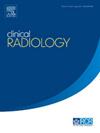A novel calibration of vertebral bone quality score for the evaluation of osteoporosis in the lumbar spine
IF 1.9
3区 医学
Q2 RADIOLOGY, NUCLEAR MEDICINE & MEDICAL IMAGING
引用次数: 0
Abstract
Aim
The magnetic resonance imaging (MRI)–based vertebral bone quality (VBQ) score can be used as a screening tool for identifying patients who may have osteoporosis; however, a significant influence of the magnetic fields of 1.5 T and 3.0 T on the score has been reported. The purpose of this study was to introduce a novel calibration to overcome the problem.
Materials and Methods
We standardised fat infiltration measurement by calibrating the VBQ score to subcutaneous fat, terming it the calibrated-VBQ score. We retrospectively collected patients who underwent both the 1.5-T and 3.0-T MRI examinations. The self-paired VBQ score, a modified-VBQ score, and the calibrated-VBQ score were compared between different magnetic fields. Correlation analysis and receiver operating characteristic (ROC) curve analysis were performed.
Results
The study included 83 patients (mean age: 67.7 ± 8.3 years). The analysis of self-paired patients revealed that the 1.5-T and 3.0-T magnetic fields had no influence on the calibrated-VBQ score, whereas a significant influence on the VBQ scores and the modified-VBQ score was found. By correlation analysis and ROC curve analysis, a better diagnostic effect of the calibrated-VBQ score for osteoporosis could be found than with the VBQ score and the modified-VBQ score.
Conclusion
The calibrated-VBQ score could overcome the inconsistency between the magnetic fields of 1.5 T and 3.0 T, and it could be considered as a better screening tool for osteoporosis compared with the traditional VBQ scores.
一种评估腰椎骨质疏松症的椎体骨质量评分的新校准方法。
目的:基于磁共振成像(MRI)的椎体骨质量(VBQ)评分可作为鉴别骨质疏松症患者的筛查工具;然而,有报道称,1.5 T和3.0 T的磁场对分数有显著影响。本研究的目的是引入一种新的校准方法来克服这个问题。材料与方法:我们通过标定皮下脂肪的VBQ评分,将脂肪浸润测量标准化,称之为标定VBQ评分。我们回顾性收集了同时接受1.5 t和3.0 t MRI检查的患者。比较不同磁场下的自配对VBQ、修正VBQ和校准VBQ得分。进行相关分析和受试者工作特征(ROC)曲线分析。结果:纳入83例患者,平均年龄67.7±8.3岁。对自配对患者的分析显示,1.5 t和3.0 t磁场对校正后的VBQ评分无显著影响,而对校正后的VBQ评分有显著影响。通过相关分析和ROC曲线分析发现,校正后的VBQ评分对骨质疏松症的诊断效果好于校正后的VBQ评分和修正后的VBQ评分。结论:校正后的VBQ评分能够克服1.5 T与3.0 T磁场不一致的问题,与传统的VBQ评分相比,可作为骨质疏松症的一种更好的筛查工具。
本文章由计算机程序翻译,如有差异,请以英文原文为准。
求助全文
约1分钟内获得全文
求助全文
来源期刊

Clinical radiology
医学-核医学
CiteScore
4.70
自引率
3.80%
发文量
528
审稿时长
76 days
期刊介绍:
Clinical Radiology is published by Elsevier on behalf of The Royal College of Radiologists. Clinical Radiology is an International Journal bringing you original research, editorials and review articles on all aspects of diagnostic imaging, including:
• Computed tomography
• Magnetic resonance imaging
• Ultrasonography
• Digital radiology
• Interventional radiology
• Radiography
• Nuclear medicine
Papers on radiological protection, quality assurance, audit in radiology and matters relating to radiological training and education are also included. In addition, each issue contains correspondence, book reviews and notices of forthcoming events.
 求助内容:
求助内容: 应助结果提醒方式:
应助结果提醒方式:


